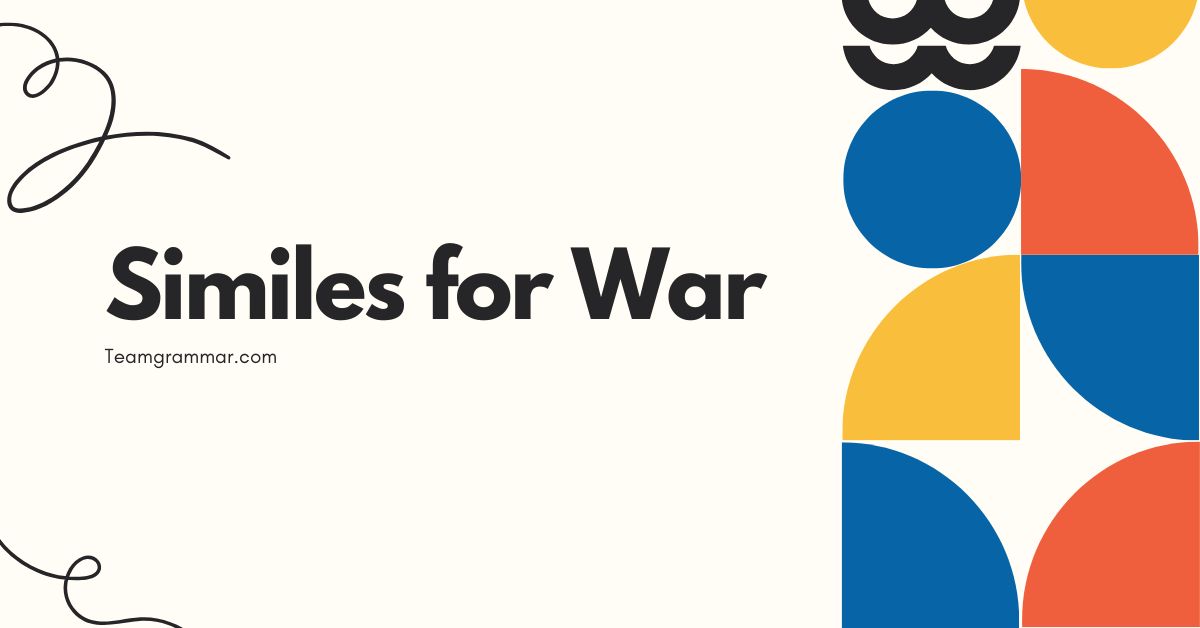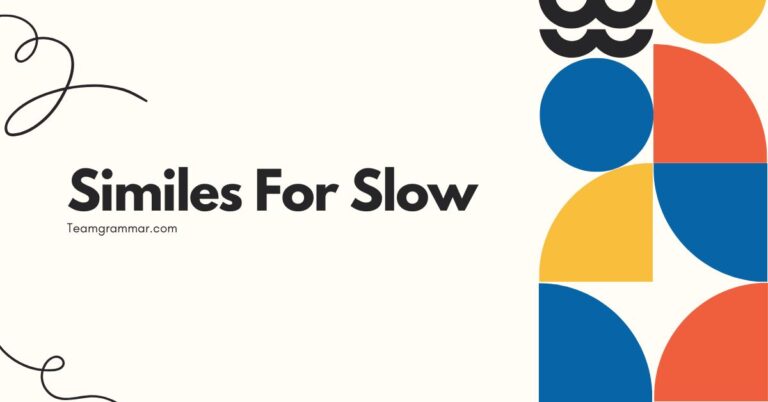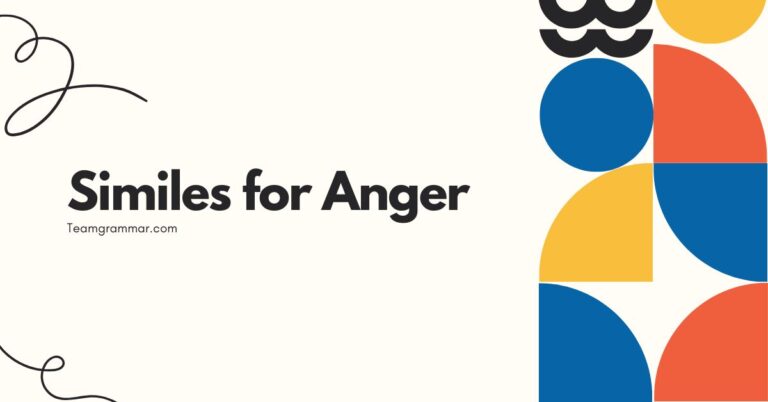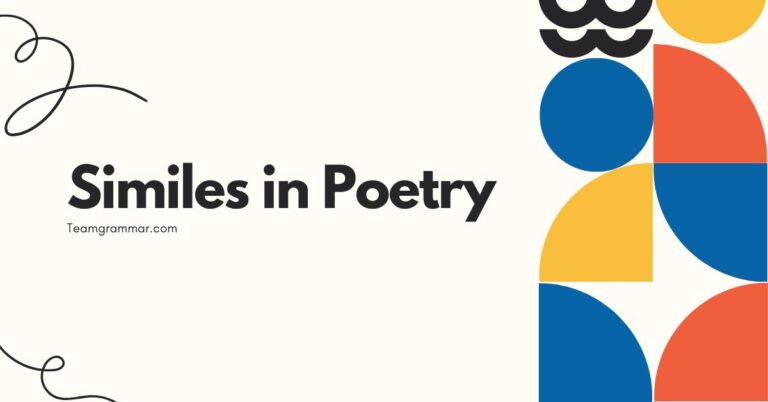31 Similes for War: Enhancing Your Descriptive Language
Understanding similes is crucial for enhancing descriptive writing and comprehension. Similes, by comparing two unlike things using “like” or “as,” add depth and vividness to language.
This article focuses on similes specifically related to “war,” exploring their grammatical structure, various types, and effective usage. Mastering war-related similes is particularly beneficial for students, writers, and anyone interested in literature, history, or improving their command of the English language.
By exploring these similes, we can better appreciate the power of figurative language and its ability to convey complex ideas and emotions.
Table of Contents
- Introduction
- Definition of Simile
- Structural Breakdown
- Types of Similes for War
- Examples of Similes for War
- Usage Rules
- Common Mistakes
- Practice Exercises
- Advanced Topics
- FAQ
- Conclusion
Definition of Simile
Asimileis a figure of speech that compares two unlike things using the words “like” or “as.” Its primary function is to create a vivid image or enhance understanding by drawing a parallel between something familiar and something less so. Similes are a type of figurative language, meaning they are not meant to be taken literally.
Instead, they invite the reader or listener to make a connection and understand the subject in a new light.
In the context of war, similes allow writers and speakers to convey the intensity, chaos, and emotional impact of conflict in a more relatable and impactful way. By comparing aspects of war to everyday experiences or familiar concepts, similes can evoke strong emotions and create a deeper understanding of the subject matter.
The use of similes can transform a factual account of war into a powerful and evocative narrative.
Similes are classified as a form ofanalogy, but they are more explicit than metaphors, which imply a comparison without using “like” or “as.” The context in which a simile is used significantly affects its meaning and impact. For instance, a simile used in a historical text will have a different connotation than one used in a contemporary poem.
Recognizing the nuances of similes is essential for effective communication and literary analysis.
Structural Breakdown
The basic structure of a simile consists of three main components: thesubject, thelinking word(like or as), and theobject of comparison. The subject is the thing being described or compared; in the context of this article, it will often be related to war.
The linking word (“like” or “as”) establishes the comparison. The object of comparison is the thing to which the subject is being likened.
The general pattern is: Subject + Linking Word + Object of Comparison. For example, “The battlefield waslikea scene from hell.” Here, “battlefield” is the subject, “like” is the linking word, and “a scene from hell” is the object of comparison.
This structure is fundamental to understanding and constructing effective similes.
Similes can be modified and expanded upon to create more complex and nuanced comparisons. Adjectives and adverbs can be added to both the subject and the object of comparison to provide more detail and specificity.
For example, “The soldiers advancedasbravelyaslions in the face of danger.” The addition of “bravely” modifies the action of the soldiers, enhancing the vividness of the comparison.
Types of Similes for War
Similes for war can be categorized based on the specific aspects of war they describe, such as the intensity of battle, the emotional impact on soldiers and civilians, or the physical destruction caused by conflict. Understanding these categories can help writers and speakers choose the most appropriate simile to convey their intended meaning.
Similes Describing the Intensity of Battle
These similes focus on the chaotic, violent, and overwhelming nature of combat. They often use imagery related to natural disasters, wild animals, or other intense experiences to convey the ferocity of war.
Examples include: “The battle ragedlikea wildfire” or “The explosions soundedasdeafeningasa thunderclap.” These similes aim to capture the sensory overload and sheer power of warfare.
Similes Describing the Emotional Impact of War
These similes explore the psychological effects of war on soldiers and civilians, such as fear, grief, and trauma. They often use imagery related to sadness, loss, or mental instability.
Examples include: “His eyes were emptylikea vacant house” or “Her heart achedasif it had been shattered into a million pieces.” These similes highlight the human cost of war and its lasting impact on individuals and communities.
Similes Describing Physical Destruction
These similes focus on the physical devastation caused by war, such as destroyed buildings, ravaged landscapes, and the human toll of injuries and death. They often use imagery related to decay, ruin, or violence.
Examples include: “The city lay in ruinslikea forgotten tomb” or “The wounded soldier lookedasbrokenasa discarded doll.” These similes aim to convey the scale and severity of the destruction caused by armed conflict.
Similes Describing Strategic Aspects of War
These similes relate to the planning, tactics, and strategic maneuvers employed during warfare. They often use comparisons to games, puzzles, or other strategic activities.
Examples include: “The general moved his troopslikepieces on a chessboard” or “The ambush was sprungaspreciselyasa well-oiled machine.” These similes highlight the intellectual and calculated nature of military operations.
Examples of Similes for War
The following tables provide extensive examples of similes related to war, organized by the categories discussed above. Each example is designed to illustrate the specific type of comparison being made and its intended effect.
Examples Describing the Intensity of Battle
This table presents similes that capture the raw, overwhelming intensity of combat. They use vivid imagery to convey the chaos, violence, and sensory overload of war.
| Simile | Explanation |
|---|---|
| The battle was like a storm unleashed. | Compares the battle to a powerful and destructive natural event. |
| The explosions sounded as deafening as the roar of a thousand lions. | Emphasizes the overwhelming noise of the explosions. |
| The fighting was like a raging inferno, consuming everything in its path. | Highlights the destructive and all-encompassing nature of the conflict. |
| The soldiers charged like a tidal wave, unstoppable and relentless. | Illustrates the force and determination of the advancing troops. |
| The enemy attacked as fiercely as a pack of wolves. | Conveys the aggressive and predatory nature of the enemy. |
| The gunfire rattled like a swarm of angry bees. | Depicts the rapid and incessant sound of gunfire. |
| The war zone was like a cauldron of chaos, bubbling with violence. | Emphasizes the chaotic and unpredictable nature of the war zone. |
| The bombs fell as relentlessly as rain during a monsoon. | Highlights the constant and overwhelming bombardment. |
| The battle raged like a tempest at sea. | Compares the battle to a chaotic and violent storm. |
| The soldiers fought as bravely as cornered tigers. | Emphasizes the courage and desperation of the soldiers. |
| The air crackled like static electricity. | Depicts the tension and anticipation before an attack. |
| The ground trembled as if a giant was walking. | Emphasizes the immense power of the explosions. |
| The war was like a beast, devouring everything in its wake. | Illustrates the destructive and insatiable nature of war. |
| The screams echoed as loudly as thunder. | Highlights the intensity of the suffering. |
| The tanks rumbled like prehistoric monsters. | Conveys the intimidating presence of the tanks. |
| The fire spread like venom through veins. | Depicts the rapid and destructive spread of fire. |
| The conflict escalated as quickly as a wildfire in dry grass. | Emphasizes the rapid escalation of the conflict. |
| The intensity of the battle was like standing at the center of a volcano. | Highlights the overwhelming and dangerous nature of the battle. |
| The attack came as suddenly as a lightning strike. | Illustrates the swift and unexpected nature of the attack. |
| The battlefield was like a chessboard after a furious game. | Depicts the chaotic aftermath of the battle. |
| The machine guns spat bullets like a dragon breathes fire. | Emphasizes the rapid and destructive output of the machine guns. |
| The enemy advanced as relentlessly as the tide. | Conveys the unstoppable nature of the enemy’s advance. |
| The situation deteriorated like a house of cards in a hurricane. | Highlights the rapid and catastrophic collapse of the situation. |
Examples Describing the Emotional Impact of War
This table presents similes that delve into the psychological and emotional toll of war on individuals and communities. They use imagery related to sadness, loss, and trauma to convey the human cost of conflict.
| Simile | Explanation |
|---|---|
| His eyes were empty like a vacant house. | Depicts the emotional hollowness and trauma experienced by the soldier. |
| Her heart ached as if it had been shattered into a million pieces. | Emphasizes the intense grief and loss felt by the person. |
| The memories haunted him like ghosts from the past. | Illustrates the persistent and disturbing nature of traumatic memories. |
| His hope dwindled as slowly as a candle burning out. | Conveys the gradual loss of hope and optimism. |
| The silence was heavy like a shroud. | Highlights the oppressive and mournful atmosphere. |
| His spirit was broken like a shattered vase. | Depicts the irreversible damage to his emotional state. |
| She felt as lost as a ship without a compass. | Emphasizes the sense of disorientation and helplessness. |
| The fear gripped him like a vise. | Illustrates the intense and paralyzing nature of fear. |
| The trauma lingered like a shadow. | Conveys the persistent and inescapable nature of the trauma. |
| His smile was fragile like thin ice. | Depicts the vulnerability and impermanence of his happiness. |
| Her voice trembled as if she was walking on eggshells. | Highlights the nervousness and fragility of her emotional state. |
| The guilt weighed on him like a leaden cloak. | Emphasizes the burden and oppressiveness of guilt. |
| His soul was scarred like a war-torn landscape. | Depicts the permanent damage to his inner self. |
| She felt as numb as if her heart had been frozen. | Conveys the emotional detachment and lack of feeling. |
| The pain was constant like a dull ache in an old wound. | Highlights the persistent and unrelenting nature of the pain. |
| His dreams were haunted like a haunted house. | Illustrates the disturbing and unsettling nature of his dreams. |
| She moved as slowly as if time had stopped. | Emphasizes the sense of stagnation and emotional paralysis. |
| The grief consumed her like a fire. | Depicts the overwhelming and destructive nature of grief. |
| His courage was tested like metal in a furnace. | Highlights the extreme pressure and resilience required. |
| The hope flickered as weakly as a dying ember. | Conveys the diminishing and fragile nature of hope. |
| Her tears flowed like a river. | Emphasizes the abundance and intensity of her sorrow. |
| The silence after the battle was like the breath before a scream. | Highlights the tension and anticipation of further violence. |
| His face was a mask like a stone statue. | Depicts the emotional detachment and stoicism. |
Examples Describing Physical Destruction
This table presents similes that focus on the physical devastation caused by war, such as destroyed buildings, ravaged landscapes, and the injuries and deaths of people.
| Simile | Explanation |
|---|---|
| The city lay in ruins like a forgotten tomb. | Depicts the complete destruction and desolation of the city. |
| The wounded soldier looked as broken as a discarded doll. | Emphasizes the physical and emotional damage inflicted on the soldier. |
| The landscape was scarred like an old battlefield. | Illustrates the lasting impact of war on the environment. |
| The buildings crumbled as easily as sandcastles. | Conveys the fragility and vulnerability of the structures. |
| The streets were littered like a garbage dump. | Highlights the disorder and decay of the war-torn area. |
| The forest was decimated like a field after a locust plague. | Depicts the complete destruction of the natural environment. |
| The bodies lay scattered as carelessly as fallen leaves. | Emphasizes the disregard for human life. |
| The bridge was destroyed like a child’s toy. | Conveys the ease and completeness of the destruction. |
| The earth was scorched like a baker’s oven. | Highlights the intense heat and destruction caused by explosions. |
| The village was leveled like a sandcastle before the tide. | Depicts the complete obliteration of the village. |
| The hospital was overflowing like a dam about to burst. | Emphasizes the overwhelming number of casualties. |
| The debris was piled high as if mocking the sky. | Highlights the scale of the destruction and its impact on the landscape. |
| The trees were stripped bare like skeletons reaching for the sky. | Depicts the desolation and lifelessness of the environment. |
| The smell of death hung in the air like a heavy fog. | Conveys the pervasive and oppressive presence of death. |
| The houses stood empty as ghostly monuments to the past. | Emphasizes the abandonment and loss associated with the destruction. |
| The fields were barren like a desert. | Depicts the infertility and desolation of the land. |
| The walls were riddled with holes like Swiss cheese. | Highlights the extensive damage caused by gunfire and explosions. |
| The river ran red as if stained with blood. | Conveys the violence and bloodshed of the conflict. |
| The ground was cratered like the surface of the moon. | Depicts the extensive damage caused by bombs and artillery. |
| The survivors wandered as aimlessly as ghosts. | Emphasizes the sense of loss and disorientation. |
| The buildings collapsed like dominoes. | Depicts the rapid and cascading destruction. |
| The once-vibrant city was now like a black and white photograph. | Highlights the loss of life and color. |
| The rubble was piled up as if trying to reach the heavens. | Emphasizes the scale and extent of the destruction. |
Examples Describing Strategic Aspects of War
This table presents similes that relate to the planning, tactics, and strategic maneuvers employed during warfare, often using comparisons to games, puzzles, or other strategic activities.
| Simile | Explanation |
|---|---|
| The general moved his troops like pieces on a chessboard. | Compares the strategic deployment of troops to the calculated moves in a chess game. |
| The ambush was sprung as precisely as a well-oiled machine. | Emphasizes the meticulous planning and execution of the ambush. |
| The battle plan unfolded like a carefully crafted puzzle. | Illustrates the complexity and interconnectedness of the strategic plan. |
| The troops advanced as cautiously as a cat stalking its prey. | Conveys the stealth and deliberate nature of the advance. |
| The strategy was implemented like a delicate surgical procedure. | Highlights the precision and skill required for the operation. |
| The siege tightened like a noose around the city. | Depicts the increasing pressure and isolation of the besieged city. |
| The defense was impenetrable like a fortress. | Emphasizes the strength and resilience of the defensive position. |
| The retreat was executed as smoothly as a dance. | Conveys the coordination and precision of the withdrawal. |
| The intelligence gathering was like piecing together a jigsaw puzzle. | Illustrates the process of collecting and analyzing information. |
| The campaign was planned as meticulously as a clockwork mechanism. | Highlights the detailed and precise planning involved. |
| The flanking maneuver unfolded like a serpent coiling around its prey. | Depicts the strategic encirclement of the enemy. |
| The information was guarded as closely as a state secret. | Emphasizes the importance and confidentiality of the information. |
| The negotiations proceeded like a high-stakes poker game. | Illustrates the strategic maneuvering and calculated risks involved. |
| The communication network operated as efficiently as a well-tuned engine. | Highlights the reliability and effectiveness of the communication system. |
| The propaganda spread like a virus. | Depicts the rapid and pervasive spread of the propaganda. |
| The attack was timed as precisely as a synchronized watch. | Emphasizes the perfect coordination of the attack. |
| The logistics were managed like a complex supply chain. | Illustrates the intricate and interconnected nature of the logistics operation. |
| The defenses were layered like an onion. | Depicts the multiple layers of protection. |
| The surveillance was constant as the watchful eyes of a hawk. | Highlights the vigilance and attentiveness of the surveillance operation. |
| The counterattack was launched as fiercely as a cornered animal. | Emphasizes the desperation and intensity of the counterattack. |
| The plan was executed as flawlessly as a perfectly rehearsed performance. | Depicts the smoothness and precision of the execution. |
| The deception worked like a charm. | Highlights the effectiveness of the deception strategy. |
Usage Rules
Using similes effectively requires understanding the nuances of comparison and ensuring clarity and relevance. The primary rule is to ensure that the two things being compared share a common characteristic that is relevant to the intended meaning.
The comparison should enhance understanding and create a vivid image in the reader’s mind.
Clarityis essential. The simile should be easily understood and not require the reader to make convoluted connections.
Avoid using obscure or overly complex comparisons that may confuse the reader. The more straightforward and relatable the comparison, the more effective the simile will be.
Relevanceis also crucial. The object of comparison should be relevant to the subject being described and contribute to the overall meaning of the text.
Avoid using comparisons that are arbitrary or unrelated, as they will detract from the impact of the simile.
Originalitycan also enhance the effectiveness of a simile. While common similes can be useful, creating original comparisons can add a unique and memorable quality to your writing.
However, originality should not come at the expense of clarity or relevance.
Avoid cliches. Overused similes, such as “brave as a lion” or “quiet as a mouse,” have lost their impact and can make your writing sound uninspired.
Strive to create fresh and original comparisons that will engage the reader.
Common Mistakes
One common mistake is using similes that are illogical or nonsensical. For example, “The explosion was like a quiet whisper” is illogical because explosions are inherently loud.
The comparison should be based on a shared characteristic that is relevant to both the subject and the object of comparison.
Another common mistake is using similes that are too vague or general. For example, “The battle was like something bad” is too vague to be effective.
The simile should provide specific details and create a clear image in the reader’s mind.
Using similes that contradict the intended meaning is also a common mistake. For example, “The soldiers were as cowardly as lions” contradicts the common association of lions with bravery.
The simile should reinforce the intended meaning and not create confusion.
Incorrect: The war was like a peaceful day.
Correct: The war was like a raging storm.
Incorrect: The soldier was as happy as a funeral.
Correct: The soldier was as sad as a funeral.
Incorrect: The city was like nothing.
Correct: The city was like a ghost town.
Practice Exercises
Test your understanding of similes for war with the following practice exercises. Fill in the blanks with appropriate words or phrases to complete the similes.
Exercise 1
Complete the following similes related to the intensity of war.
| Question | Answer |
|---|---|
| The bombs fell like __________. | rain |
| The battle raged as fiercely as __________. | a wildfire |
| The soldiers fought like __________. | lions |
| The explosions sounded as deafening as __________. | thunder |
| The enemy advanced like __________. | a swarm of bees |
| The conflict spread as quickly as __________. | a virus |
| The artillery fired like __________. | a volcano erupting |
| The attack came as suddenly as __________. | lightning |
| The war zone was like __________. | a scene from hell |
| The guns roared as loud as __________. | a thousand cannons |
Exercise 2
Complete the following similes related to the emotional impact of war.
| Question | Answer |
|---|---|
| His heart was as heavy as __________. | lead |
| Her eyes were empty like __________. | a vacant house |
| The memories haunted him like __________. | ghosts |
| Her hope dwindled as slowly as __________. | a dying ember |
| The silence was heavy like __________. | a shroud |
| His spirit was broken like __________. | a shattered vase |
| She felt as lost as __________. | a ship without a compass |
| The fear gripped him like __________. | a vise |
| The trauma lingered like __________. | a shadow |
| His smile was fragile like __________. | thin ice |
Exercise 3
Complete the following similes related to physical destruction.
| Question | Answer |
|---|---|
| The city lay in ruins like __________. | a forgotten tomb |
| The wounded soldier looked as broken as __________. | a discarded doll |
| The landscape was scarred like __________. | an old battlefield |
| The buildings crumbled as easily as __________. | sandcastles |
| The streets were littered like __________. | a garbage dump |
| The forest was decimated like __________. | a field after a locust plague |
| The bodies lay scattered as carelessly as __________. | fallen leaves |
| The bridge was destroyed like __________. | a child’s toy |
| The earth was scorched like __________. | a baker’s oven |
| The village was leveled like __________. | a sandcastle before the tide |
Advanced Topics
For advanced learners, exploring the use of extended similes, also known as epic similes, can add depth and complexity to writing. Extended similes are longer and more detailed comparisons that can span several lines or even paragraphs.
They allow for a more thorough exploration of the similarities between the subject and the object of comparison.
Another advanced topic is the use of similes in different literary genres and historical contexts. The effectiveness of a simile can vary depending on the genre and the intended audience.
For example, a simile used in a poem may be more metaphorical and evocative than one used in a historical text, which may be more factual and descriptive.
Analyzing the use of similes in the works of famous authors can also provide valuable insights into the art of simile construction. Studying how authors like Shakespeare, Hemingway, and Orwell use similes can help you develop your own skills and techniques.
Furthermore, exploring the cultural and linguistic variations in the use of similes can broaden your understanding of figurative language. Different cultures may have different associations and connotations for certain objects and concepts, which can affect the interpretation of similes.
FAQ
- What is the difference between a simile and a metaphor?
A simile explicitly compares two things using “like” or “as,” while a metaphor implies a comparison without using these words. For example, “He is like a lion” is a simile, while “He is a lion” is a metaphor.
- Can a simile be too obvious?
Yes, a simile can be too obvious if it states the obvious or uses a cliche. Effective similes should provide new insights or create vivid images.
- How can I make my similes more original?
To create original similes, avoid using common comparisons and think about unique and unexpected similarities between the subject and the object of comparison. Consider using imagery from your own experiences and observations.
- What is the role of context in understanding similes?
Context is crucial for understanding similes because it provides the necessary background information and cultural associations to interpret the comparison accurately. The same simile can have different meanings in different contexts.
- Are similes only used in literature?
No, similes are used in various forms of communication, including everyday conversation, journalism, and advertising. They are a versatile tool for enhancing description and understanding.
- How do I avoid using clichéd similes?
To avoid clichéd similes, make a conscious effort to think of fresh and original comparisons. Read widely and pay attention to how other writers use figurative language. Experiment with different combinations of words and images.
- Can a simile be used ironically?
Yes, a simile can be used ironically by comparing two things that are contradictory or unexpected. This can create a humorous or satirical effect.
- How do I choose the right simile for my writing?
To choose the right simile, consider the intended meaning, the audience, and the overall tone of your writing. Select a comparison that is clear, relevant, and engaging.
- What are the benefits of using similes in writing?
Similes enhance descriptive writing by making it more vivid, engaging, and memorable. They can also help readers understand complex ideas by relating them to familiar concepts.
- How can I improve my ability to create effective similes?
Practice creating similes regularly by observing the world around you and thinking about creative comparisons. Read widely and analyze how other writers use similes. Seek feedback from others on your writing.
Conclusion
Mastering the use of similes, especially those related to war, significantly enhances one’s ability to write vividly and evocatively. By understanding the structure, types, and usage rules of similes, writers and speakers can effectively convey the intensity, emotional impact, and physical destruction associated with conflict.
Avoiding common mistakes and practicing regularly are key to developing this skill.
Remember that effective similes should be clear, relevant, and original. By incorporating these principles into your writing, you can create powerful and memorable descriptions that resonate with your audience.
Continue to explore and experiment with different comparisons to refine your craft and expand your expressive range.
Ultimately, the skillful use of similes is a valuable tool for anyone seeking to improve their command of the English language and communicate more effectively. Whether you are a student, writer, or simply someone who appreciates the power of language, mastering similes will undoubtedly enrich your understanding and appreciation of the written word.







